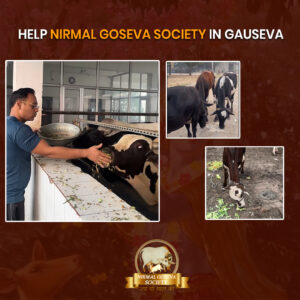Nirmal Goseva
A sanctuary for retired cows rescued from accidents and abandonment, providing them a safe and caring environment.
Why the Cow?
The cow is revered as a sacred mother in many beliefs. It is said that before being born as a human, the soul passes through the womb of a cow, and after death, it re-enters a cow’s body based on karma. In households experiencing death, cows or bulls are often seen nearby, symbolizing spiritual significance. Offerings are made to cows to honor ancestors.
The cow is also linked to the power of Gayatri, the mother, and its hump contains the Surya Ketu Nadi, which absorbs cosmic energies. Caring for cows and their calves is believed to transfer positive energy that balances the body, environment, and soul. Conversely, harming or consuming cows is thought to bring negative effects, including disease and painful rebirths. Many religions and even modern medicine recognize the harmful impact of consuming cow beef on human health.
Cow Protection through History
Throughout history, India’s leaders have protected and revered the cow. King Prithu, from whom the earth derives its name, famously milked a cow to end a famine and save humanity. Lord Krishna, a beloved figure, was a cow herder, and Arjun risked 14 years of exile to protect cattle during the Viratnagar war.
Rulers like King Nahush, Manu Needhi Cholan, Mughal emperors Akbar and Jahangir, and Sultan Hyder Ali banned cow slaughter to safeguard the animals. Even Ranjit Singh, founder of the Sikh Empire, enforced such a ban in the 19th century. The Marathas and Bahadur Shah Zafar also took similar actions.
The first slaughterhouse in India, set up in Calcutta in 1760, could kill 30,000 animals daily. Soon after, Bengal suffered devastating famines, and Robert Clive, who introduced the slaughterhouse, tragically took his own life. This historical context suggests a link between the mistreatment of cows and misfortune.
Caring for cows, however, is seen as a foundation for prosperity and well-being.

